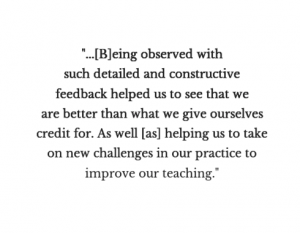The Overarching Project:
This summer I worked under the supervision of Professor Cann on a project that studies what co-teachers from different cultural, linguistic, and preparation backgrounds can learn from one another in a dual immersion education setting. The participatory action research (PAR) project itself, a professional development intervention program, was conducted in the spring of 2015 at a rural, K-11 bilingual school in Costa Rica, with two teams of co-teachers (each with one U.S. teacher and one Costa Rican/Tican teacher). In the first week of my internship, I conducted interviews with teachers and former administrators in order to document a brief history of professional development at the school. In conjunction with the school’s bilingual coordinator, I dedicated my time to conducting a preliminary analysis of qualitative data – including interviews, surveys, field notes, and audio recorded sessions – to see 1) what teachers can learn from one another in a professional learning community (PLC) and 2) the benefits of such a process. These efforts went towards writing two proposals in hopes of presenting research findings at the American Educational Research Association conference in 2016.
Brief Summary of Results:
The PLC session data revealed that through peer observation, teachers learned new strategies for student engagement. These strategies include different ways of teaching a particular lesson, reading instruction strategies, and classroom management techniques, as well as when to implement these strategies. Some teachers identified specific strategies in their peers’ practice that they were interested in implementing in the classroom. These included developing more routines in their classroom, attempting new language-based activities, addressing the class as a whole, and focusing on time efficiency, among other strategies. After adapting strategies from other teachers and implementing them in their own classrooms, some teachers expressed desire to change the adopted strategy to suit their particular teaching style.

Anonymous, Respondent 4, Feedback Survey
In the process of examining student writing, teachers were able to reflect on their own expectations of student writing and what they value in writing. When analyzing student writing samples, most teachers commented on sentence structure, idea development, and clear expression of ideas. Some teachers also noted the students’ honesty in answering the prompt and staying on topic. Tican Spanish teachers in particular, however, commented on the aesthetic of the work, such as handwriting, and grammar, such as accents. After working together, they realized the importance of relating class material to the student’s lives in order to keep students interested in their writing.
In listening to other teachers discussing their observations, they were able to notice aspects of their own teaching through their peers’ eyes, such as effectiveness of their own classroom instruction and the power of classroom culture. Teachers also reported that the benefits of this process (and by extension, the PLC group), were: being able to become familiar with peers on a “deeper professional level” (Anonymous Respondent in Feedback Survey), recognizing the best practices and applying them, and becoming comfortable with being observed.
Looking Ahead
What teachers can learn from one another through PLCs in a bilingual context is an understudied realm of bilingual education. Thus, we aim to continue this project with the teachers themselves as the lead facilitators of the program. In addition, we hope to present our findings at the 2016 AERA conference in order to share our findings.


